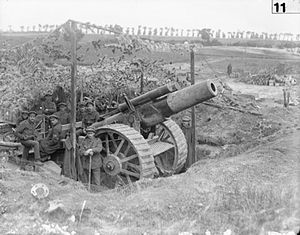BL 8 inch Howitzer Mk 1 - 5
| BL 8-inch howitzer Mk V | |
|---|---|

Eight-inch howitzer Mk V near Carnoy, Battle of Albert, July 1916
|
|
| Type | heavy howitzer |
| Place of origin | United Kingdom of Great Britain and Ireland |
| Service history | |
| In service | 1915−1918 |
| Wars | World War I |
| Production history | |
| Designer | Major M L Wilkinson, RGA |
| No. built | 91 |
| Specifications | |
| Weight | Gun & Breech: 5 Long tons Total: 13.5 Long tons |
| Barrel length |
Bore: 9 ft 10 in to 10 ft 5 in (3.00−3.18 m) |
|
|
|
| Shell | HE : 200 lb (91 kg), bagged charge |
| Calibre | 8 inches (203 mm) |
| Recoil | Hydro-spring constant. 18-, 13- or 13.25-inch |
| Elevation | -5°−45° |
| Traverse | nill |
| Muzzle velocity | Maximum: 1,301 ft/s (397 m/s) |
| Maximum firing range | 10,500 yd (9,600 m) |
Bore: 9 ft 10 in to 10 ft 5 in (3.00−3.18 m)
The BL 8-inch howitzer Mark I through to Mark V (1 to 5) were a British improvisation developed early in the First World War to provide heavy artillery. It used shortened and bored-out barrels from various redundant naval 6-inch guns.
It bore no relation to the later 8-inch howitzer of the First World War, the Vickers 8-inch Mark VI to VIII howitzers which succeeded it.
The weapon entered service in February 1915.
The Mark I–V had many relatively minor differences in the carriages and trails and Mk IV, Mk VI and QF Mk II 6-inch naval gun barrels were used. However, the ballistic characteristics, propellant charges and shells used were similar for all Mks I–V. They are easily identified by their short thick barrel and twin recoil buffers above the barrel.
Mks I–IV were no longer repaired from summer 1917 onwards.
They were operated by siege batteries of the Royal Garrison Artillery (RGA). Holt caterpillar tractors were used to tow them into position.
Mks I–V were limited by a short range and high weight, being 4–5 tons heavier than the succeeding Mk VI which was designed as a howitzer and hence had a much lighter barrel.
The improvised nature of the design led to failures such as premature explosion and unreliability in action, and difficulties of maintenance in workshops. There were also early quality-control problems with British mass production of ammunition in 1915 and early 1916 : "the 8-inch fuses failed so often that the battlefield was littered with unexploded 8-inch shells".
Despite their shortcomings they were generally considered a success :
"They were monstrous things and extremely heavy, but the machinery of the guns was very simple and that's why they did so extremely well and didn't give nearly as much trouble as some of the more complicated guns that came to appear later on. One was the very first to be made and it was marked, 'Eight-inch Howitzer No. 1 Mark I' so we called that gun, 'The Original'. It was marvellously accurate". Second Lieutenant Montague Cleeve, 36th Siege Artillery Battery, Royal Garrison Artillery.
They remained in use on the Western Front throughout the First World War as Britain's need for heavy artillery increased and was never fully met by production of modern equipment.
...
Wikipedia
